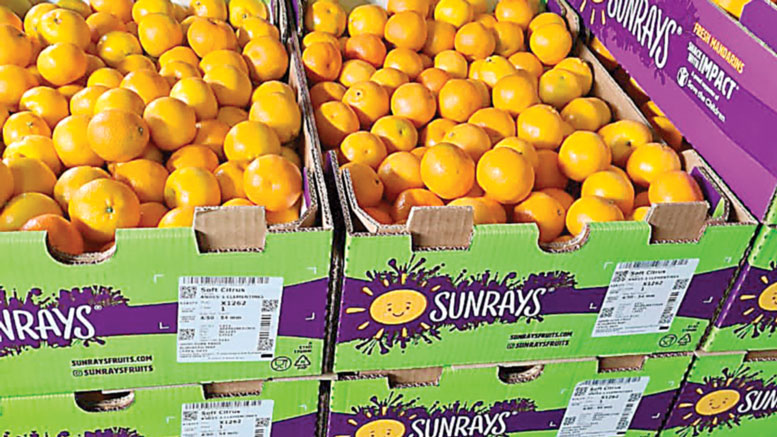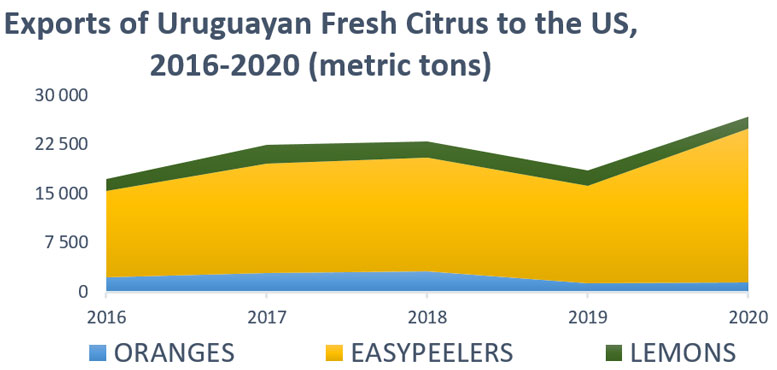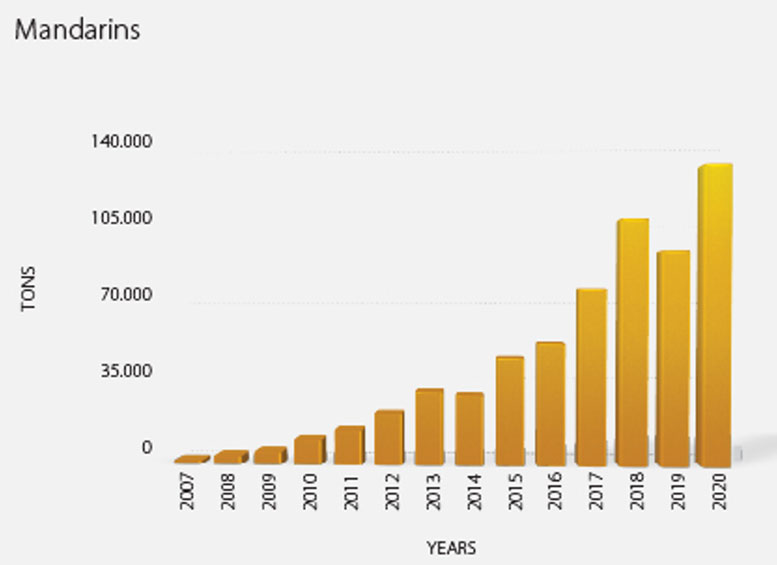The Sky’s The Limit For Southern Hemisphere Citrus
June 17, 2021 | 11 min to read
Consumer demand for citrus remains strong as individuals return to active summer lifestyles post-lockdown, with mandarins leading the trend for healthy, snackable options. The World Citrus Organization predicts a 12.7% increase in global citrus exports, driven by ideal growing conditions. Retailers benefit from year-round availability, allowing for enticing summer displays. Despite prior challenges, pricing has stabilized, and production is expected to rise, particularly for easy peelers and Navels as health-conscious choices prevail.

Demand remains robust as consumers venture out post-lockdown, especially for healthy, snackable mandarins.
Originally printed in the May 2021 issue of Produce Business.
Summer citrus from the Southern Hemisphere is here to stay on North American retail shelves, as supply and demand rise in tandem.
Last year’s COVID-19 outbreak caused soaring purchases of immunity-boosting fruits, like Vitamin C-rich lemons, easy peelers and oranges. For 2021, continued higher-than-average demand is expected, especially if citrus is positioned as a healthy, on-the-go snack for consumers returning to active summer lifestyles.

The World Citrus Organization (WCO) forecasts global citrus exports from the Southern Hemisphere will increase by 12.7 percent to 3.8 million tons this year, driven by soft citrus and lemons. Growing conditions reportedly have been ideal, prompting importer-distributors to anticipate good availability and sizes.
RETAILER BENEFITS
The Southern Hemisphere accounts for 27 percent of the international citrus market, according to WCO. The region’s counter-seasonal climate means many prized varieties are widely available in U.S. and Canadian supermarkets during the summer.
“When you have a product that consumers come to know and love, they expect to see it in stores, and want the consistency of year-round availability,” says Chris Cockle, senior director of retail sales at Wonderful Citrus, Los Angeles, CA. He cites Wonderful Halos mandarins as an example.
The Southern Hemisphere plays a “very important role” in ensuring that fresh citrus remains on shelves year-round, adds James Milne, Oppy’s senior vice president of categories and marketing. Headquartered in Vancouver, Canada, Oppy sources summer citrus from South America, South Africa and Australia.
“The Northern Hemisphere simply can’t do it alone,” Milne says. “It means retailers can offer a robust line of produce for picnics and barbecues through the summer, front and center. A great advantage is if other summer crops aren’t producing volume as well as hoped, retailers have citrus to continue building exciting displays through the season.”
John Paap, brand manager at Tarrytown, NY-based importer, Jac. Vandenberg, agrees citrus is “fantastic” to carry year-round. “In addition to the already familiar health benefits of Vitamin C and building immunity, citrus fruits are great for a variety of summer dishes and beverages such as salads, grilling, juices, etc.,” he says. “They also make for great on-the-go snacks as we start to travel more.”
Citrus is no longer a seasonal fruit, as efforts by marketers to grow year-round demand have paid off, comments Karen Brux, managing director for the Chilean Fresh Fruit Association (CFFA) in San Carlos, CA.
“There are so many opportunities for retailers to promote and further drive demand,” Brux says. She suggests linking citrus with health and fitness events, promoting summer grilling ideas for lemons or Navel oranges, or running back-to-school promotions for mandarins — “everyone’s favorite portable, snackable fruit.”
“We also have lots of fun Halloween ideas for retailers to showcase, like our Bubbling Witches Brew.”
NO LONGER PRICING, VOLUME CHALLENGES
Another positive is that importers and exporters believe pricing and sporadic volume challenges of the past have been overcome.
“Prices have evened out between the Southern and Northern Hemispheres,” confirms Milne at Oppy. “There may be a slight premium, but because of different pack style options, consumers can pick a size suited to their own budget and consumption patterns.”
The past seasons have shown “tremendous growth” in availability, adds Cockle from Wonderful Citrus, which imports easy peelers and oranges from Chile and South Africa during the U.S. summer, supplemented by product from Peru and Uruguay. The group sources lemons from Argentina and Chile.
“Supply is no longer a concern, especially August through October, up until the domestic season in November. For the first time ever, we have enough volume to promote and manage the sometimes challenging seasonal transitions more easily for customers. We are excited to promote Halos with confidence through October and November as we transition into the California crop.”
The Union of Fruit Producers and Exporters of Uruguay (Upefruy) concurs. “Exporters have consolidated calendars for the whole season to avoid sporadic volumes entering the market, and we have not felt resistance to imported fruit,” says Upefruy representative Marta Bentancur.
This summer, however, Cockle warns that container shortages, port restrictions and other logistical issues will remain a concern, given worldwide supply chain challenges. “We’re hopeful they will improve over the next several months,” he explains.


Uruguay usually directs its easy peeler, lemon and orange shipments to the Port of Philadelphia. For 2021, however, Bentancur says USDA-APHIS has permitted Uruguay access through any U.S. port.
VOLUME RISING
Looking ahead, the “sky’s the limit” for Southern Hemisphere citrus, following consistent growth over the last five years, foresees Rodrigo Lopez, category director of citrus and avocados at Oppy.
“There is definitely more demand,” Lopez says, adding that Oppy recently hired Sergio Ruiz in Mexico, and Sila Louw in South Africa, in anticipation of expanded offerings. “I think there will be an evolution from the boom of 2020, with demand increasing on a more sustainable basis.”
Additional country suppliers and expanding production are also a factor. With new countries of origin such as Argentina and Uruguay gaining access to the market, along with significant acreage expansion in others, there has been a lot of growth, Lopez says. “Australia and South Africa have been growing exponentially as well.”
Although a relatively small supplier, Australia exports a range of premium citrus to North America, predominantly Navels, as well as mandarins, lemons and grapefruit. In time, grower representative body Citrus Australia, in Mildura, Victoria, expects “modest growth,” following recent gains. Canada, in particular, saw a sharp increase during 2020.
“Our production base is growing; consumer demand for healthy, safe produce is growing; and our countries have stable and trusted relationships,” explains Citrus Australia Chief Executive Nathan Hancock.
As Australian mandarin production expands, Hancock expects the export growth to North America seen during the past three years will continue. Daisy mandarins, which are bright red to orange, as well as W. Murcott Afourer mandarins, have been popular, he says.
Since the U.S. market opened to Uruguay in 2016, its presence has increased year-on-year with mandarins, oranges and lemons. “Uruguay is a very small supplier in volume compared with our competitors, but we expect to continue growing our participation in the U.S. through very strict quality, food safety and calendar compliance,” says Upefruy representative Bentancur.
Uruguay is undergoing a significant varietal change, with its easy peeler production shifting to seedless Tango, W. Murcott and Orri varieties, among others, including local cultivars, on more than 1,000 hectares (2,471 acres) of new and re-planted acreage.
Likewise, 2,000 hectares (4,942 acres) of new groves will increase production of new lemon varieties, plus approximately 100 hectares (247 acres) of orange groves have been replanted with Navel varieties in particular.
Chile is a major summer citrus supplier to the U.S., which received 84 percent of Chilean supply in 2020. Throughout the last five years, CFFA reports that global exports of Chilean clementines, lemons, mandarins and oranges have all risen. Most increased gradually, while mandarins have registered “huge growth” since 2007.
Production continues to expand, too. In 2021, the Chilean Citrus Committee projects a 6 percent export increase to 387,000 tons, of which 85 percent will go to the U.S. Global exports of Chilean mandarins alone will rise by 11 percent to 145,000 tons, following an “incredible” 40 percent jump in 2020.
MANDARINS IN THE LEAD
Easy peelers — especially mandarins, which have recorded the most significant growth — remain the drivers of summer citrus sales.

“With their sweet interior and thin, zipper skin, they have skyrocketed in popularity as a common lunchbox and snacking favorite,” says Oppy’s Lopez. “Easy peelers are convenient, which increases the chance of impulse buying — a reason why promotions are very effective.”
Small and seedless are other positive attributes, notes Paap. Mandarins account for approximately half of the 28,000 tons of citrus imported by Jac. Vandenberg, and this year Murcott mandarins will deliver the firm’s biggest volume growth.
Meanwhile, Navel oranges — which had been losing sales momentum to the popularity of easy peelers — have experienced a revival. “Last summer, many retailers saw better growth in Navel sales compared to easy peelers,” Paap says. “The question now is: Will improved demand for Navels continue as life gets back to normal post COVID?”
Within Navels, Paap singles out Cara Cara as one variety that is gaining favor as more retailers include the fruit in their regular citrus programs.
Hancock at Citrus Australia agrees that Cara Caras, plus Kirkwood Navels, are increasingly popular. “Cara Caras have orange skins but a pink-red flesh that consumers love, and great flavor too,” he says. “North America has also been a good market for Australian blood oranges. These are typically a little smaller with a red blush on their skin and very dark purple flesh — popular to make juice, cocktails and to garnish salads or desserts.”
ROBUST DEMAND
For 2021, summer citrus imports are trending to be stronger than two years ago, although it will be difficult to beat last year’s sales surge.
“Many people turned to citrus as a go-to food during COVID, some of whom never or rarely ate citrus before,” says Jac. Vandenberg’s Paap, “and it is likely that many will continue to buy citrus going forward as they live their ‘new normal.’”
Oppy expects to import staples like lemons, easy peelers and Navels, along with specialty citrus such as Cara Caras, blood oranges, Minneolas, and others. “Everything is looking good and comparable with previous years,” says Lopez. “Timing is on track, quality is consistent, volumes are solid and growing conditions are good. Overall, it is a favorable season, and we’re seeing decent growth at 10-15 percent from all regions.”

Milne at Oppy adds there is diversity in sizing across producing countries, which will provide a “nice balance” in the market.
Wonderful Citrus anticipates “very strong” quality for South African easy peelers, with good sizes. “We also expect to see a lot of small fruit from Chile driven by a larger fruit set,” Cockle says.
“Export volumes are expected to be significantly up for easy peelers due to new plantings in South Africa and Chile, as well as reduced demand from the UK and Europe,” continues Cockle. “For lemons, exports are slightly up, driven by logistical and access challenges in Europe that were solved, while exports for Navels remain flat.”
Last year’s rainfall in Chile’s central region replenished reservoirs and boosted production. “Growing conditions have been ideal for good brix and sizing, while cool nights will give easy peelers and Navels a brilliant orange color,” comments Juan Enrique Ortúzar, Chilean Citrus Committee president.
Uruguay’s 2021 production has rebounded with the end of fairly serious drought and improved weather, resulting in good sizing and coloration. “We expect almost a 25 percent increase in exports [to the U.S.] this year,” says Upefruy’s Bentancur. “Mandarins started two weeks earlier than in 2020, while oranges and lemons are looking normal.”
Australian production has experienced a “very good year” too. “The fruit is a great size for export markets such as North America, and it’s tasting excellent, with good color,” reports Hancock of Citrus Australia. “I think marketing this year will be very easy — the fruit should sell itself.
First arrivals of Australian citrus are expected in late July, he says, and would continue until October. “Demand may be tempered by the economic impact in certain markets, however we believe consumers will want to take steps to keep healthy, and that will include fresh fruit like citrus.”
MERCHANDISING WINS
With sales riding high on the back of the pandemic, retailers would do well this summer to reinforce the message of consuming citrus for nutrient intake and rehydration. In addition to Vitamin C, citrus contains essential antioxidants, carotenoids, folic acid, potassium and dietary fiber.
Furthermore, marketers suggest in-store displays will be a “great tool” to drive increased sales as vaccinated consumers feel comfortable returning to stores. “The displays don’t always have to be grandiose, but they should be creative and eye-catching, and placed as close as possible to the front of the store,” advises Paap, of Jac. Vandenberg.
Cross-merchandising is also recommended for incremental sales. “Citrus is versatile, and great for all kinds of creative cross-promotions with other complementary items in and outside of the produce department,” points out Cockle of Wonderful Citrus. “Displaying point-of-sale in secondary locations beyond the produce aisle, including at checkout and lobby entrances, can help retailers maximize visibility and attract shoppers’ attention.”
To target shoppers who have moved online, timing digital marketing with product availability will be critical for maximum impact. Paap also says retailers may want to consider including a free piece of citrus with online orders to encourage consumers to try something new.

